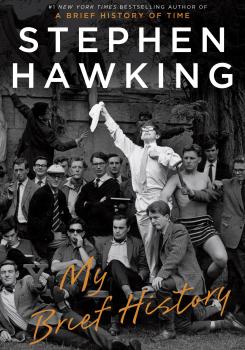How Stephen Hawking Got Sucked Into Black Holes
An excerpt from “My Brief History.”
The following is an excerpt from My Brief History, by Stephen Hawking. Copyright © 2013 by Stephen W. Hawking.
My work on black holes began with a eureka moment in 1970, a few days after the birth of my daughter, Lucy. While getting into bed, I realized that I could apply to black holes the causal structure theory I had developed for singularity theorems. In particular, the area of the horizon, the boundary of the black hole, would always increase. When two black holes collide and merge, the area of the final black hole is greater than the sum of the areas of the original holes. This, and other properties that Jim Bardeen, Brandon Carter, and I discovered, suggested that the area was like the entropy of a black hole. This would be a measure of how many states a black hole could have on the inside for the same appearance on the outside. But the area couldn’t actually be the entropy, because if black holes had entropy, they would also have a temperature and would glow like a hot body. As everyone thought, black holes were completely black and didn’t emit light or anything else.
There was an exciting period culminating in the Les Houches summer school in 1972 in which we solved most of the major problems in black hole theory. In particular, David Robinson and I proved the no-hair theorem, which said that a black hole would settle down to a state characterized by only two numbers, the mass and the rotation. This again suggested that black holes had entropy, because many different stars could collapse to produce a black hole of the same mass and rotation.

All this theory was developed before there was any observational evidence for black holes, which shows that Feynman was wrong when he said an active research field has to be experimentally driven. The one problem that was never solved was to prove the cosmic censorship hypothesis, though a number of attempts to disprove it failed. It is fundamental to all work on black holes, so I have a strong vested interest in its being true. I therefore have a bet with Kip Thorne and John Preskill on the outcome of this problem. It is difficult for me to win this bet, but quite possible for me to lose if anyone finds a counterexample with a naked singularity. In fact, I lost an earlier version of the bet, by not being careful enough about the wording. Thorne and Preskill were not amused by the T-shirt I offered in settlement.
Excerpted from My Brief History, by Stephen Hawking. Copyright © 2013 by Stephen W. Hawking. Excerpted by permission of Bantam, a division of Random House LLC. All rights reserved. No part of this excerpt may be reproduced or reprinted without permission in writing from the publisher.
Stephen Hawking was the Lucasian Professor of Mathematics at the University of Cambridge for 30 years. He is the author of several books, including the worldwide publishing phenomenon A Brief History of Time.